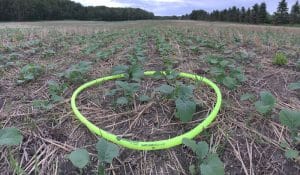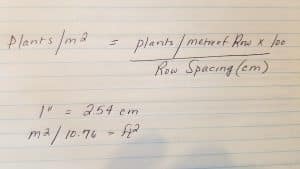Plant counts quantify the success of canola plant establishment. Use multiple counts to get an average plant density for that field, then compare this to target plant density and emergence percentage. This will help with management decisions in that crop, and will identify areas for improvement. This short video shows how to use the Canola Calculator.
While making canola plant counts in the two weeks after emergence, also look for signs of missing plants. If time is short, consider hiring someone to scout. Read the Canola Encyclopedia chapter on evaluating the stand.
How to count with a hula hoop
- Quarter (0.25) square metre hoop. Use a hoop with an inside diameter of 56 cm and circumference of 177 cm which provides an area of 0.25 of a square metre. Count the number of plants inside the hoop, and multiply by 4 to get plants per square metre. To convert to plants per square foot divide the plants per square metre by 10).
- Two square foot hoop. Use a hoop with an inside diameter of 19″ and circumference of 60″, which provides an area of two square feet. Count the number of plants inside the hoop and divide by two to get plants per square foot. Counting with this larger hoop (instead of a one foot square hoop) will incorporate plants from two seed rows and give a larger sample size, helping improve accuracy of counts.
- For other sized hoops, determine the area using the formula A=πr2 (r= radius, half the diameter, π = 3.14).

How to count with a metre stick
- Use a metre stick and count the seedlings per metre of row. Take that number and multiply by 100 then divide by the seed spacing in cm to get plants per square metre.
- For example, 25 plants per metre multiplied by 100 then divided by 25 cm (10” row spacing) is 100 plants per square metre (approximately 10 per square foot).
- Do not include volunteer canola plants in plant density counts or emergence calculations. Look for blue seed coats attached to seedling root systems and avoid counting plants which are growing outside of seed rows.
Low counts? Here are common causes
While doing the plant counts, take this time to scout for missing plants and ongoing threats to the young crop. Causes for missing or weakened plants include:
Fertilizer toxicity. High rates of nitrogen, sulphur, potassium and even phosphorus placed in the seed row can greatly increase mortality if the seeding equipment has low seed bed utilization (SBU) and soils are dry. Toxicity damage often occurs in patterns, being worse in dryer or lighter parts of the field that don’t have the moisture to diffuse fertilizer concentrations beside the seed. You may also notice differences row to row if some openers are worn more than others and not providing required seed/fertilizer separation. For these reasons, it’s always a good idea to leave a small check strip with no seed-placed fertilizer, to gauge the fertilizer effect on seed emergence and mortality. Unsafe rates of seed-placed fertilizer don’t always decimate plant stands, but they can frequently delay emergence. The Canola Encyclopedia has more.
Herbicide carryover. This will be higher risk in areas where application rates were the highest – areas of headland overlaps, for example – and in areas that tend to be drier. Hilltops are more susceptible since they can be lower in organic matter, reducing the buffering capacity of those areas, and they remain drier, resulting in less opportunity for breakdown to occur. Note that with herbicide carryover, plants need to be growing to take up herbicide, so it will usually be a case of damaged plants rather than missing plants. Canola Encyclopedia has more on herbicide carryover.
Frost damage. Frost can cause leaves to turn yellow or brown, then dry up and fall off. Severe frost damage can also cause pinching of the stem up near the growing point, closer to the cotyledon. Disease can also cause pinching of the stem, but disease pinching tends to occur closer to the soil surface or below the surface where the hypocotyl remains white. Regular scouting makes this diagnosis easier, especially if you know the stand looked good the day before a frost. A healthy growing point is an indicator that plant will survive through the damage. More on what to do after a spring frost.
Wind. Strong winds can shear off canola seedlings. It can blow away the top inch of soil and the seed along with it in some areas, while burying small seedlings in others. This will create patches within a field. Losses tend to be worse on hilltops.
Seedling disease. Stem and hypocotyl (the part of the seedling’s stem below the cotyledons and down to the seed) damage near the soil surface and below is likely seedling disease. Seedling diseases can be more common in canola seeded too deep into cool and wet soils. Because the plant takes that much longer to emerge and because the size of the vulnerable hypocotyl area is that much longer than with a shallow seeded plant, the plant is more susceptible to seedling diseases. Canola Encyclopedia on seedling disease complex. Podcast and video.
Cracked seed. Seed that is very dry is more prone to cracking as it moves through the drill, which can reduce germination rates. A slower fan speed will help to reduce damage.
Seed rate. Large seed (higher thousand seed weight) seeded at a low seeding rate will result in fewer seeds per square foot compared to small seed. It may result in only a few seeds per square foot. Proper calibration is another potential factor, especially with a new drill. It is difficult to scout for a lack of seeds, but look in the seed row for any un-germinated seeds or signs of seedling mortality, to rule out other causes.
Insect damage. Cutworm feeding, for example, results in notched, wilted, dead or cut-off plants. Plants may be gone entirely. Flea beetles will congregate and feed in patches across the field as they arrive, so check for foliar leaf damage and stem feeding. Severe feeding can cause plants to dry up and disappear. Stem feeding can break off plants.
Excess moisture. Flooded soils can stop root function and kill canola seedlings within a matter of days. Bottom leaves will tend to yellow first. This damage will be more common in low spots.
Crusting. Rain after seeding can often cause top soil to crust, stopping the emergence of canola seedlings. Canola seedlings can’t penetrate the crust, and often curl back and die. No research has been conducted to show the best ways to break up crusting and free the crop. If a few plants have emerged, it may be best to leave them be and hope for more rain to soften the soil surface.
Dry seedbed. With limited seedbed moisture, canola seeds can just sit there waiting for enough moisture for germination. Missing plants due to lack of moisture tend to be worse in the driest parts of a field. In some cases, seeds can start to take on moisture, but can’t get enough to sustain growth. This results in desiccation and death of the seed or germinated seedling. This can also happen when soil dries down to the working depth, which may be below the seedrow. This more commonly occurs when high winds and a dry spell occur in the four to six days after seeding.
Seeder issues. Repeatable patterns in rows or groups of rows usually suggest a mechanical issue with the drill. Single rows could be plugged. Whole manifolds could have plugged feeder hoses. One wing of the drill could be going deeper. Shanks could be stretched. Openers behind the tractor wheels could be worn more than others and not placing seed properly. The pattern can often tell you where on the machine the problem occurred. Packing pressure, residue management, opener type and seeder type can all influence seed placement and stand establishment. Disk versus knife openers have pros and cons depending on soil type, moisture, residue, and seed bed quality. All opener and packer styles have pros and cons depending on soil type, moisture, residue and seedbed quality.
Seeding depth. Seeding too deep can greatly reduce emergence rates and increase seedling disease. Seeding too shallow can also result in reduced emergence, usually a result of extreme dry conditions and fluctuating temperatures that occur at the soil surface.
In some cases we can never really know for sure the causes for a thin stand. In those cases, calendar date, soil moisture conditions and the upcoming forecast should be carefully considered before going so far as reseeding the field. Canola has an incredible ability to compensate and branch out in low density situations- depending on the specific scenario, “leaving it” may be best option.

